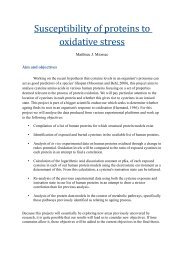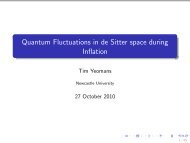Retinal Prosthesis Dissertation - Student Home Pages
Retinal Prosthesis Dissertation - Student Home Pages
Retinal Prosthesis Dissertation - Student Home Pages
You also want an ePaper? Increase the reach of your titles
YUMPU automatically turns print PDFs into web optimized ePapers that Google loves.
E.g. choosing a frame rate of 100 gives a spike time of 39.0625ns and a partial spike<br />
time of 9.7656.25 ns from a subset of the table (fps_calcs.xls) used to construct the<br />
above chart.<br />
fps T f T ae (@1024 T ae (ns) T long_pulse T spike_pulse T partial_spike<br />
f pixel<br />
25 0.04 3.906E-05 39062.5 781.25 156.25 39.0625 25600<br />
50 0.02 1.953E-05 19531.25 390.625 78.125 19.53125 51200<br />
75 0.013333 1.302E-05 13020.83 260.4167 52.08333 13.02083 76800<br />
100 0.01 9.766E-06 9765.625 195.3125 39.0625 9.765625 102400<br />
Table 6 T spike related to fps<br />
The partial spike time refers to the quarter component part of the biphasic pulse<br />
which can be accommodated using the clock pulse (10ns) of a typical FPGA running<br />
at 100MHz. For this chapter, dealing with AER stream production, we could put this<br />
consideration on hold and typify the AER sender chip as operating at circa 25MHz<br />
with an address event timing of T ae = 39062.5 ns and a spike time of 156.25 ns.<br />
For one pixel of an image at maximum intensity there will be fifty `outerpulses’ i.e.<br />
the actual spike plus the time before another one is allowed; or makes sense. As this<br />
pixel information must be transmitted in one second; each outerpulse, in real time,<br />
must take 0.02s. So in conventional terms for a frame rate of 50fps then each pixel,<br />
during propagation, experiences one outerpulse per frame albeit at faster than `real<br />
time’. As biologically the innerpulse (comprising `spike’ plus recovery time) takes<br />
4ms (0.004s) this implies an `off’ time; at maximum intensity of (0.02-0.004) equals<br />
0.016s, again in `real time’, as has been previously stated. Using an example of a<br />
1024 pixel image at 50fps as each frame takes 0.02s then the serialised time for a
















